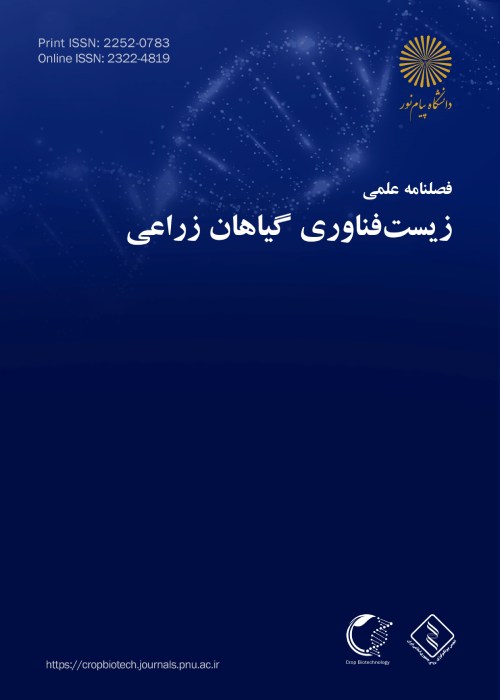Studying the relationship between traits obtained from callus induction in the mature embryo stage and agronomic traits of bread wheat in different moisture conditions
This study was aimed to investigate the reaction of wheat different genotypes to callus induction in the mature embryo stage and the relationship between the traits obtained from the tissue culture and the agronomic traits. A field experiment was conducted in the form of randomized complete block design with three replications under rainfed and irrigated conditions in Razi University. In the callus induction stage, mature embryos of 25 bread wheat genotypes from a factorial experiment in the form of a completely randomized basic design including two factors, genotype at 25 levels and 2, 4-D hormone at 3 levels of 1, 2 and 3 mg/L and kinetin 0.2 mg/L was used in six replications. Variance analysis in tissue culture conditions showed that there is a significant difference between genotypes in terms of all investigated traits except the percentage of relative water content of callus. Cluster analysis under laboratory and field conditions showed that genotypes No. 15 (WC-47638), 6 (WC-4840), 13 (WC-5001), 18 (WC-47569) and the Pishtaz cultivar were jointly superior in both conditions and they took the highest values of callus diameter, callus fresh weight, callus growth rate, grain yield, chaff yield, xteragen length, grain weight per spike, peduncle to height ratio, harvest index, seed filling period, vegetative growth rate and seed filling rate. Based on the path analysis in irrigation conditions, the traits of 1000 seed weight, number of seeds per spike, vegetative growth rate, length of other internodes, number of spikes per square meter, grain weight per spike and days to appearance of spike have the most direct effect on tissue culture traits. Also, according to the first canonical function for tissue culture traits (V1) and agronomic traits (W1) in rainfed conditions, plants with higher values of grain yield, larger callus diameter, and with a higher weight of 1000 seeds have a higher callus growth rate and in irrigation conditions, plants with high grain yield and grain weight per spike, callus growth speed is higher. Based on the obtained results, the investigated traits are suitable criteria for selecting cultivars in in vivo and in vitro conditions.
- حق عضویت دریافتی صرف حمایت از نشریات عضو و نگهداری، تکمیل و توسعه مگیران میشود.
- پرداخت حق اشتراک و دانلود مقالات اجازه بازنشر آن در سایر رسانههای چاپی و دیجیتال را به کاربر نمیدهد.



